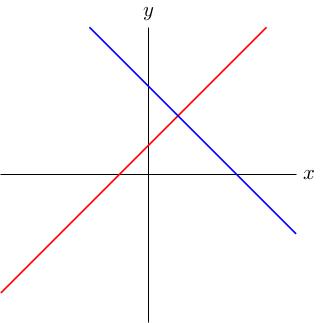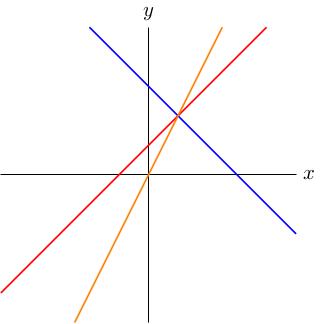The vector a_1, a_2 is orthogonal to L. (It's also called the "normal vector to L").
17. Geometric viewpoint on simultaneous equations, 1
17. Geometric viewpoint on simultaneous equations, 1
In this video and the next, we'll develop a geometric point of view on simultaneous equations.
2 variables
We've repeatedly studied the system of equations x minus y equals minus 1, x plus y equals 3. We saw this has the unique solution x = 1, y = 2. Geometrically, x minus y equals minus 1 and x + y = 3 define lines in the x y-plane: the first (red) is y = x + 1 (slope 1, y-intercept 1), the second (blue) is y equals minus x + 3 (slope minus 1, y-intercept 3):

They intersect at exactly one point, namely (1, 2). This is precisely the solution of the equations (x = 1, y = 2). That makes sense: the first line is the set of points whose x and y coordinates satisfy x minus y equals minus 1, the second line is the set of points whose coordinates satisfy x + y = 3; the intersection is the set of points whose coordinates satisfy both equations.
So solving simultaneous linear equations in two variables is the same thing as intersecting lines.
Let's add another equation: x minus y equals minus 1, x + y = 3, 2 x minus y = 0. This adds another line (orange) into our diagram.

Since these lines have a common triple intersection point (1, 2), this is still a solution to this system of equations.
If we had picked a slightly third different equation, defining a line which didn't pass through (1, 2), there would be no solutions. For example: x minus y = minus 1, x + y = 3, 2 x minus y = 1, defines three lines which have no triple intersection point, so there is no common solution.

Lines in the plane
Each equation a_1 x + a_2 y = b defines a line in the plane. A solution of the system of equations is a common intersection point between these lines.
The line L consisting of points (x, y) in R 2 such that a_1 x + a_2 y = b is equivalent to y = minus a_1 x over a_2 + b over a_2 (if a_2 is nonzero, otherwise it's vertical), so the slope is minus a_1 over a_2 (infinity if a_2 = 0).
If I pick two points x, y and x prime, y prime on L then their difference x minus x prime, y minus y prime points along L, so it's sufficient to check that a_1, a_2 dot x minus x prime, y minus y prime equals 0 We have a_1, a_2 dot x minus x prime, y minus y prime equals a_1 x + a_2 y minus a_1 x prime minus a_2 y prime, which equals b minus b = 0, since a_1 x + a_2 y = a_1 x prime + a_2 y prime = b (both points lie on L).